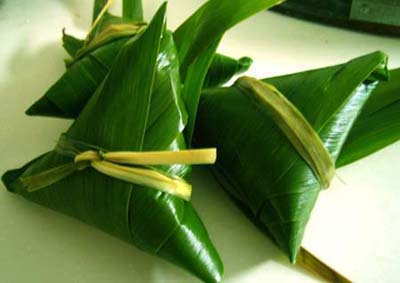Sunday marks the annual Dragon Boat Festival and it promises to be a feast for the senses - a cacophony of sound, a blaze of color and tastes and smells to excite.
For most, the month of June signifies the middle of the year. But according to the Chinese lunar calendar, the fifth month has just begun and people are preparing to celebrate another traditional festival - Duanwu Jie.
Otherwise known as the Dragon Boat Festival, it takes place on the fifth day of the fifth month on the lunar calendar, and this year it falls on Sunday.
As is so often the case with traditional festivals, there is a special food to mark the occasion as well as all the fun of the event.
Also there will be the chance to see some very exciting dragon boat race in Dingxi River in the suburban Qingpu District, a sometimes misty 3-kilometer waterway.
The dragon boats which hold at least 14 people are long, narrow and painted red with a colorful dragon's head high on the bow. The captain stands at the front of the boat waving a small flag while at the back another crew member beats a drum to mark a rhythm for the oarsmen to follow.
When boats jump into action from the starter's gun, rushing forward like flying arrows and amidst the banging of drums and cries from the crowd, it is an unforgettable scene.
While dragon boat races provide a feast of festive action, glutinous rice dumplings called "zongzi" are also a tasty highlight. They are available all year round but come into their own during the Dragon Boat Festival.

Rice dumplings
While people on the Chinese mainland call these rice dumplings zongzi, in Hong Kong they are called joong and in Taiwan they are tzang.
The similarity between all these rice dumplings are that they are all made with glutinous rice but complemented with different fillings and wrapped in fresh reed leaves. They are then steamed or boiled in a pot.
Salty zongzi is more popular in South China while up north they prefer a sweeter variety with fillings such as dates, red bean paste or jujubes.
In Guangdong Province, zongzi has a more distinctive savory flavor. Some are stuffed with diced chicken; others with diced duck, lean pork, egg yolk and mushroom.
Some types of zongzi, on the other hand, have no filling and are eaten with sugar or syrup. Yet, while the shapes and fillings vary from region to region, they are mostly wrapped either in triangular or pyramidal shape.
To honor the tradition of making and eating zongzi during this festival, a special zongzi-making class will be held on Sunday at The Kitchen at Huaihai Lu. Together with local Shanghainese ladies, people will be able to wrap four rice dumplings to take home. Reservations are a must.
But for those lacking in culinary skills or time to make zongzi, there are stores all around Shanghai. A zongzi with both meat and salted duck's yolk filling costs 3.8 yuan (55 US cents) at Wang Jia Sha Restaurant, a Shanghainese restaurant on Nanjing Road W.
Another household name in Shanghai is Wu Fang Zhai from Jiaxing, Zhejiang Province. The glutinous rice is complemented with a delicious combination of pork, Chinese sausage, Shitake mushrooms, salted duck's egg, cooked peanuts, dried shrimp and chestnuts.
The Shanghai No. 1 Food Store on Nanjing Road Pedestrian Mall is also offering a variety of zongzi until Sunday with Gong De Lin (known for vegetarian products), Wu Fang Zhai and Xing Hua Lou among the brands.
(Shanghai Daily June 6,2008)